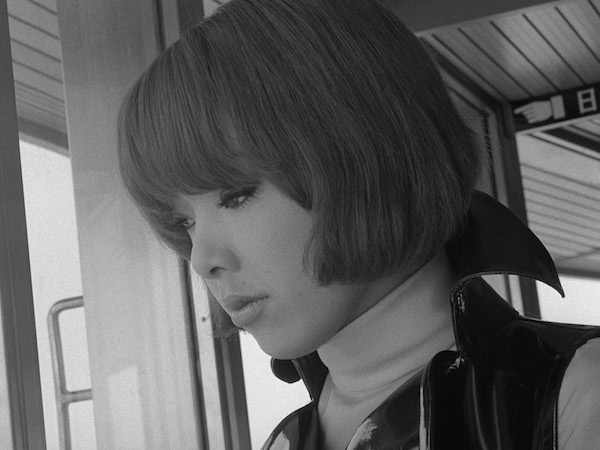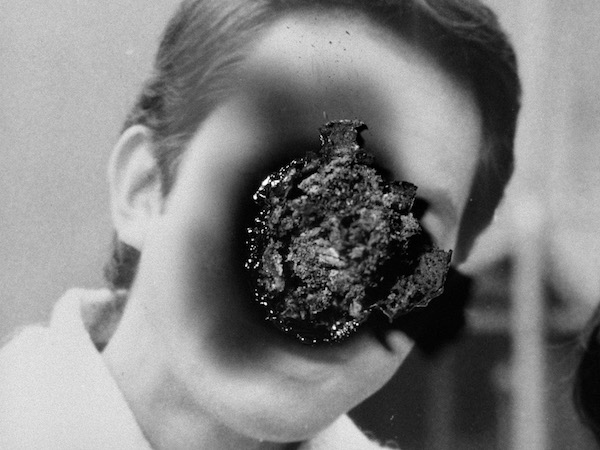
BY SCOTT STIFFLER | From protester/police clashes in the streets to hipster-packed groping sessions in darkened apartments to bitter rivalries that topple the power structure of a “gay boys bar,” simmering unrest is the spark that ignites explosive acts of lust and violence in writer and director Toshio Matsumoto’s gorgeous, gripping, sexually assertive feature film debut.
Subtitled in the original 1969 English language version press kit as “Aesthetics of cruelty and perversion” — a description that’s both accurate and understated — “Funeral Parade of Roses” is set in and around the off-grid pleasure dome Genet, where intoxicating hostesses (womanly ways, male plumbing) mix and mingle with Tokyo businessmen and American soldiers just back from Vietnam. “Mamma” Leda presides, but rising star Eddie is a threat to her professional and romantic relationship with bar manager Gonda. Up to his neck in intrigue from the accounting burdens of narcotics brokering and secret, limb-twisting liaisons with Eddie, Gonda’s discovery of a telling photo from the forbidden couple’s dark past sets in motion a final reel whose blood, betrayal, death, and destruction do graphic justice to the Greek tragedy upon which the plot is not-so-loosely based.
Rarely seen on North American screens since its brief and limited initial release — and, as result, largely absent from the roll call of watershed LGBTQ cinema — “Funeral Parade of Roses” is given richly deserved new life in the form of a 4K digital restoration that will screen locally at, appropriately, the Quad Cinema (having reopened in April after a two-year renovation process of its own; slightly less time than it took to secure, scrub, and prep the film).
Aspiring to a state of cosmetic perfection befitting its alluringly feminine gay boy protagonist, Hollywood-based distribution company Cinelicious Pics embarked on the restoration of “Parade” by sending its director of acquisitions, Ei Toshinari, overseas to consult with Hirofumi Sakamoto, of the Postwar Japan Moving Image Archive (PJMIA). Sakamoto acted as an intermediary for director Matsumoto — who, despite declining health, gave extensive notes throughout the process, and passed away just a few weeks ago. PJMIA authorized the release of the film’s original 35mm camera negative and sound elements (stored at Tokyo’s National Film Center, within the National Museum of Modern Art) for scanning by Japanese post-production facility IMAGICA, which then sent the files to Cinelicious’ team for digital restoration.
Stripped of dirt, debris, scratches, and splices while leaving the natural grain untouched “as much as possible,” the restored film’s crisp palette justifies a boast in the press material that puts Tatsuo Suzuki’s “breathtaking” black and white cinematography in league with the erotic messaging and artful framing of photographer Robert Mapplethorpe. The visual aesthetic of “Parade” certainly captivates — but so too will its emotional impact, sure to stun those unprepared for the nonlinear narrative’s flurry of intense sexual encounters, traumatic memories, art gallery visitations, “gay boy” lifestyle contemplations, gang violence, flashes of potent imagery, and popping word balloons.
All of these elements build upon 1932-born Matsumoto’s previous work as a post-war essayist and theoretician seeking to absorb journalistic and experimental techniques into his own work. “Parade” not only achieves this, but also breaks new ground for the filmmaker, in a manner both mischievously self-aware and culturally candid (such as a recurring glimpse of the titular floral element clenched between a standing male’s exquisite ass — a cheeky reference to, among other things, “rosebud,” although not the kind you know from “Citizen Kane”).

David Marriott, a co-supervisor of the restoration project and VP of acquisitions and distribution at Cinelicious, noted in a recent interview with this publication that Matsumoto’s interest in “exploring the tension between documentary and avant-garde” were “dual concerns evidenced in early shorts,” including 1961’s “Nishijin.” Elements of reality-based investigation are seen throughout “Parade,” Marriott said, particularly in “Suzuki’s cinematography and, for example, during the interview segments, many of which were real documentary interviews with people in and around the Tokyo underground scene, and during the exterior city scenes, most of which were were shot on location in heavily trafficked areas.” A pair of Matsumoto’s avant-garde short films are even given screen time in “Parade” — 1969’s “Ecstasis” unspools during a party scene, and shots from 1968’s “For My Crushed Right Eye” are, Marriott noted, “recycled into the narrative. The drug-fueled apartment dance scenes also echo similar sequences in ‘Crushed Right Eye,’ both in framing and lighting.”
Marriott hailed the film’s melting pot of influences as “everything but the kitchen sink filmmaking, in the best possible way,” noting that alongside an evolved take on the director’s use of documentary and avant-garde is an exploration of “new stylistic techniques which seem to have grown organically from his earlier work, including the film’s construction/deconstruction of linear time and the varied film-within-a-film meta dimensions.”
Matsumoto’s use of sped-up motion has been cited as the source of that technique in 1971’s “A Clockwork Orange” (in particular, the scene where Eddie’s trio boasts of their appeal to men as a prelude to battling it out with a biological girl gang). One might also be tempted to trace Malcolm McDowell’s droog drag to Eddie’s pronounced eyelashes and effective use of black mascara. Such linkage long ago embedded itself in cinematic lore — but Marriott recalled the effort to verify “is something we spent many months trying to track down,” and concluded that although still “anecdotal at this point, it’s become de facto authoritative. The way the droogs in ‘Clockwork Orange’ are framed and move, you can see a clear influence.”

No matter. Whether or not others have been inspired to admirable imitation or outright thievery takes nothing away from the experience of virgin eyes watching this “Parade” pass by for the first time. Its black and white film stock and distinct 1960s fashion statements notwithstanding, the defiant confidence and erotic potency of its lead character make the film seem utterly contemporary, even progressive.
Plucked from Tokyo’s nightlife scene — where the androgynous pixie’s Peter Pan-like dance moves and manner of dress earned the fluid monikers “Peter” and “Pîtâ” — 1952-born Shinnosuke Ikehata’s Eddie shares memorably smoldering love scenes with 1927-born Yoshio Tsuchiya’s Gonda. Already an established actor who appeared in Akira Kurosawa’s seminal 1954 film “Seven Samurai” (talk about flicks people pilfered from!), Tsuchiya was notably paired with another formidable screen presence one year before “Parade,” in the 1968 Godzilla flick “Destroy All Monsters.” Ikehata, who, Marriott said, has long been “a huge celebrity in Japan” and enjoys contemporary notoriety as “a talking head on a lot of TV programs,” also claims a place in the Kurosawa canon, having played the jester Kyoami in 1985’s “Ran.” As for “Parade,” Marriott predicted its “incredibly subversive and transgressive” core will play “almost as well, if not better, today than I imagine it did at the time.”
No matter which way you swing or how hard you land, this is one time when a trip to the cinema is a safe bet for those seeking reasonably priced, mind-expanding thrills that are anything but cheap.
Opens Fri., June 9 at Quad Cinema (34 W. 13th St., btw. Fifth & Sixth Aves.). Screenings at 1:45pm, 4:15pm, 6:45pm and 9:10pm. Runtime: 105 minutes. Black and white. Japanese with English subtitles. Cinelicious Pics will release “Funeral Parade of Roses” on Blu-ray in the late fall, with bonus content including a commentary track and remasterings of seven avant-garde shorts by Matsumoto. Visit quadcinema.com and cineliciouspics.com.

















